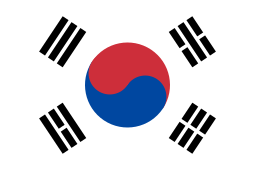Taegeukgi
 |
|
| Name |
Taegukgi / Taegeukgi (Korean: 태극기) (Hanja: ) |
|---|---|
| Use | National flag and ensign |
| Proportion | 2:3 |
| Adopted | January 27, 1883 (original version used by the Korean Empire) August 15, 1948 (Republic of Korea establishment) October 1997 (current version) |

Variant flag of Republic of Korea
|
|
| Use | Naval Jack |
| Flag of South Korea | |
| Hangul | 태극기 |
|---|---|
| Hanja | |
| Revised Romanization | Taegeukgi |
| McCune–Reischauer | T'aegŭkki |
The flag of South Korea, also known as the Taegukgi (also spelled as Taegeukgi, literally "Taeguk flag"), has three parts: a white rectangular background, a red and blue Taeguk in the center that symbolizes a balance, and four black trigrams, which are selected from the original eight, on each corner of the flag.
The flag's background is white, which is a traditional Korean color, common to the daily attire of 19th century Koreans and the color is also use for a traditional Korean wear (hanbok). It represents peace and . The circle in the middle is derived from the philosophy of yin-yang and represents the balance of the universe. The blue section represents the negative cosmic forces, and the red section represents the opposing positive cosmic forces. The trigrams together represent the principle of movement and harmony. Each trigram (hangeul: 괘 [gwae]; hanja: 卦) represents one of the four classical elements.
These four trigrams are described in the table below:
The lack of the national flag only became an issue in 1876, in the Joseon Dynasty. Before 1876, a national flag did not exist and it was not considered important. The issue began during the negotiations for the Japan–Korea Treaty of 1876. Although the delegate of the Empire of Japan had the Japanese national flag, the Joseon Dynasty could not hang a corresponding flag. Thus, there were some proposals to create a flag, but the issue was considered unimportant by the government. At 1880, the proliferation of foreign negotiations led to a need for the national flag. The most major proposal was described in the ‘Korea Strategy’ papers written by the Chinese delegate Huang Zunxian. The proposal was to incorporate the Flag of the Qing Dynasty for the Joseon Dynasty. In response to the proposal, the government sent the delegate of Lee Young-Sook to explore the possibility of the issue through the politician Li Hongzhang. Li Hongzhang agreed with some parts of the proposal, but proposed that some other factors should be differed. The Qing Dynasty agreed with Li Hongzhang, but it is unknown how far the Joseon government explored this proposal.
...
Wikipedia
